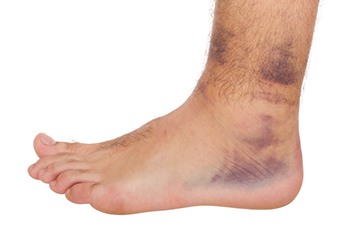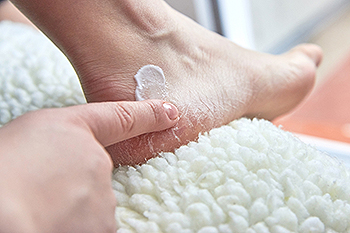April 2022
Spraining an Ankle

An ankle sprain occurs when the foot inverts and twists causing the ankle joint out of its normal position. The ankle injury is sustained on the lateral ankle complex, composed of three ligaments – talofibular, calcaneofibular, and posterior talofibular – that hold the ankle bones and joints together. There may be small tears and damage to tendons, cartilage and blood vessels and there will usually be pain when weight is placed on the affected ankle, swelling, and even bruising. Anyone can sprain an ankle but those who participate in sports, walk on uneven surfaces, or wear inappropriate footwear are more at risk. It can take several weeks, even months for a sprained ankle to heal completely. Calling a podiatrist is suggested if you feel you might have sprained your ankle to determine how severe the injury is, make sure it is not broken through various manipulations and one or more imaging studies, and to provide the proper course of treatment.
Although ankle sprains are common, they aren’t always minor injuries. If you need your ankle injury looked at, contact one of our doctors from Coral Desert Foot & Ankle. Our doctors can provide the care you need to keep you pain-free and on your feet.
How Does an Ankle Sprain Occur?
Ankle sprains are the result of a tear in the ligaments within the ankle. These injuries may happen when you make a rapid shifting movement while your foot is planted. A less common way to sprain your ankle is when your ankle rolls inward while your foot turns outward.
What Are the Symptoms?
- Pain at the sight of the tear
- Bruising/Swelling
- Ankle area is tender to touch
- In severe cases, may hear/feel something tear
- Skin discoloration
Preventing a Sprain
- Wearing appropriate shoes for the occasion
- Stretching before exercises and sports
- Knowing your limits
Treatment of a Sprain
In many cases, the RICE method (Rest, Ice, Compression, and Elevate) is used to treat ankle sprains. However, you should see a podiatrist to see which treatment option would work best with your injury. In severe cases, surgery may be required.
It is important to ask your doctor about rehab options after you receive treatment for your injury. Stretching, strength training, and balance exercises may help the ankle heal while also preventing further injury.
If you have any questions, please feel free to contact one of our offices located in St. George and Kanab, UT, and Mesquite, NV . We offer the newest diagnostic and treatment technologies for all your foot care needs.
Who Is Prone to Sever’s Disease?
 The medical term for the growth area where the plantar fascia and the Achilles tendon connect to the heel is known as the calcaneal apophysis. It starts to develop in children approximately 7 or 8 years old, and permanently fuses to the heel bone in young teenagers. Children in this age group who frequently participate in sports activities may experience a condition that is known as Sever’s disease. Common symptoms of this ailment can include intense heel pain, which can become worse when wearing shoes that have limited cushioning or arch support. Sever's disease is an irritation of the heel, which occasionally causes swelling and bruising. Successful treatment options include temporarily stopping the activity that caused the injury and resting the affected foot as often as possible. Some patients perform specific stretches that may help to increase flexibility. If you have Sever’s disease, it is suggested that you are under the care of a podiatrist who can guide you toward correct treatment options.
The medical term for the growth area where the plantar fascia and the Achilles tendon connect to the heel is known as the calcaneal apophysis. It starts to develop in children approximately 7 or 8 years old, and permanently fuses to the heel bone in young teenagers. Children in this age group who frequently participate in sports activities may experience a condition that is known as Sever’s disease. Common symptoms of this ailment can include intense heel pain, which can become worse when wearing shoes that have limited cushioning or arch support. Sever's disease is an irritation of the heel, which occasionally causes swelling and bruising. Successful treatment options include temporarily stopping the activity that caused the injury and resting the affected foot as often as possible. Some patients perform specific stretches that may help to increase flexibility. If you have Sever’s disease, it is suggested that you are under the care of a podiatrist who can guide you toward correct treatment options.
Sever's disease often occurs in children and teens. If your child is experiencing foot or ankle pain, see one of our doctors from Coral Desert Foot & Ankle. Our doctors can treat your child’s foot and ankle needs.
Sever’s Disease
Sever’s disease is also known as calcaneal apophysitis, which is a medical condition that causes heel pain I none or both feet. The disease is known to affect children between the ages of 8 and 14.
Sever’s disease occurs when part of the child’s heel known as the growth plate (calcaneal epiphysis) is attached to the Achilles tendon. This area can suffer injury when the muscles and tendons of the growing foot do not keep pace with bone growth. Therefore, the constant pain which one experiences at the back of the heel will make the child unable to put any weight on the heel. The child is then forced to walk on their toes.
Symptoms
Acute pain – Pain associated with Sever’s disease is usually felt in the heel when the child engages in physical activity such as walking, jumping and or running.
Highly active – Children who are very active are among the most susceptible in experiencing Sever’s disease, because of the stress and tension placed on their feet.
If you have any questions, please feel free to contact one of our offices located in St. George and Kanab, UT, and Mesquite, NV . We offer the newest diagnostic and treatment technologies for all your foot and ankle injuries.
Several Causes of Heel Pain
Heel pain can develop for a variety of reasons that can include plantar fasciitis, heel spurs, Sever’s disease, or an Achilles tendon injury. Many patients with heel pain can manage it when comfortable shoes are worn that have a low heel. Additionally, it is beneficial to practice specific stretches that can help heel pain. An effective stretch is defined as standing on a step and lowering one heel at a time until a gentle pull is felt. It may feel good to roll the bottom of the foot on a tennis ball, and this may help the entire foot to feel good. It is suggested to refrain from wearing high heels or shoes that are pointy, in addition to refraining from standing for long periods of time. If you have heel pain, it is strongly advised that you contact a podiatrist who can determine what the cause may be and begin the correct treatment.
Many people suffer from bouts of heel pain. For more information, contact one of our doctors of Coral Desert Foot & Ankle. Our doctors can provide the care you need to keep you pain-free and on your feet.
Causes of Heel Pain
Heel pain is often associated with plantar fasciitis. The plantar fascia is a band of tissues that extends along the bottom of the foot. A rip or tear in this ligament can cause inflammation of the tissue.
Achilles tendonitis is another cause of heel pain. Inflammation of the Achilles tendon will cause pain from fractures and muscle tearing. Lack of flexibility is also another symptom.
Heel spurs are another cause of pain. When the tissues of the plantar fascia undergo a great deal of stress, it can lead to ligament separation from the heel bone, causing heel spurs.
Why Might Heel Pain Occur?
- Wearing ill-fitting shoes
- Wearing non-supportive shoes
- Weight change
- Excessive running
Treatments
Heel pain should be treated as soon as possible for immediate results. Keeping your feet in a stress-free environment will help. If you suffer from Achilles tendonitis or plantar fasciitis, applying ice will reduce the swelling. Stretching before an exercise like running will help the muscles. Using all these tips will help make heel pain a condition of the past.
If you have any questions please contact one of our offices located in St. George and Kanab, UT, and Mesquite, NV . We offer the newest diagnostic and treatment technologies for all your foot and ankle needs.
It's Time for Beautiful Feet
What Can Cause Cracked Heels?
 Severely cracked heels are referred to as heel fissures. They are defined as cracked skin that appears on the heels, and they can often cause pain and discomfort. This condition can occur for several reasons, including being overweight, wearing shoes that have an open back, or standing for the majority of the day. Additionally, medical conditions consisting of psoriasis or eczema may contribute to the development of cracked heels. It is helpful to wash and dry the feet thoroughly, followed by applying a good moisturizer. Cracked heels can be an unsightly, uncomfortable nuisance, and it is strongly suggested that you consult with a podiatrist if this condition is affecting you.
Severely cracked heels are referred to as heel fissures. They are defined as cracked skin that appears on the heels, and they can often cause pain and discomfort. This condition can occur for several reasons, including being overweight, wearing shoes that have an open back, or standing for the majority of the day. Additionally, medical conditions consisting of psoriasis or eczema may contribute to the development of cracked heels. It is helpful to wash and dry the feet thoroughly, followed by applying a good moisturizer. Cracked heels can be an unsightly, uncomfortable nuisance, and it is strongly suggested that you consult with a podiatrist if this condition is affecting you.
Cracked heels are unsightly and can cause further damage to your shoes and feet. If you have any concerns, contact one of our doctors from Coral Desert Foot & Ankle. Our doctors can provide the care you need to keep you pain-free and on your feet.
Cracked Heels
Cracked heels appear unappealing and can make it harder for you walk around in sandals. Aside from looking unpleasant, cracked heels can also tear stockings, socks, and wear out your shoes. There are several methods to help restore a cracked heel and prevent further damage.
How Do You Get Them?
Dry skin is the number one culprit in creating cracked heels. Many athletes, walkers, joggers, and even swimmers suffer from cracked heels. Age and skin oil production play a role to getting cracked heels as well.
Promote Healing
Over the counter medicines can help, especially for those that need instant relief or who suffer from chronic dry feet.
Wear Socks – Wearing socks with medicated creams helps lock in moisture.
Moisturizers – Applying both day and night will help alleviate dryness which causes cracking.
Pumice Stones – These exfoliate and remove dead skin, which allows for smoother moisturizer application and better absorption into the skin.
Change in Diet
Eating healthy with a well-balanced diet will give the skin a fresh and radiant look. Your body responds to the kinds of food you ingest. Omega-3 fatty acids and zinc supplements can also revitalize skin tissue.
Most importantly, seek professional help if unsure how to proceed in treating cracked heels. A podiatrist will help you with any questions or information needed.
If you have any questions, please feel free to contact one of our offices located in St. George and Kanab, UT, and Mesquite, NV . We offer the newest diagnostic and treatment technologies for all your foot care needs.






